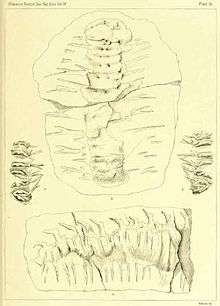Euphoberiidae
Euphoberiidae is an extinct family of archipolypodan millipedes known from the Upper Pennsylvanian of Europe and North America. The family includes relatively large millipedes measuring up to 30 cm (12 in)[1] long bearing distinctive spines and were the dominant millipedes of the Pennsylvanian.[2]
| Euphoberiidae | |
|---|---|
 | |
| Myriacantherpestes fossils | |
| Scientific classification | |
| Kingdom: | |
| Phylum: | |
| Subphylum: | Myriapoda |
| Class: | |
| Superorder: | |
| Order: | †Euphoberiida Hoffman, 1969 |
| Family: | †Euphoberiidae Scudder, 1882 |
| Genera | |
| |
Description
Euphoberiids are characterized by sets of outward-pointing spines on each diplosegment (body ring), one pair extending laterally (to the sides), the other pair higher on the body. At the base of each lateral spine is an ozopore, or defensive gland opening.[3] Species of Acantherpestes and Euphoberia have cylindrical bodies, while those of Myriacantherpestes are more flattened in appearance.[1]
References
- Shear, William A.; Edgecombe, Gregory D. (2010). "The geological record and phylogeny of the Myriapoda". Arthropod Structure & Development. 39 (2–3): 174–190. doi:10.1016/j.asd.2009.11.002. PMID 19944188.
- Shear, William A. (1997) The fossil record and evolution of the Myriapoda. In: Fortey, R. A., Thomas, R. H. (Eds.), Arthropod Relationships. Systematics Association Special Volume 55. Chapman & Hall, London, pp. 211–219
- Wilson, Heather M.; Anderson, Lyall I. (2004). "Morphology and Taxonomy of Paleozoic Millipedes (Diplopoda: Chilognatha: Archipolypoda) From Scotland". Journal of Paleontology. 78 (1): 169–184. doi:10.1666/0022-3360(2004)078<0169:MATOPM>2.0.CO;2.
This article is issued from Wikipedia. The text is licensed under Creative Commons - Attribution - Sharealike. Additional terms may apply for the media files.